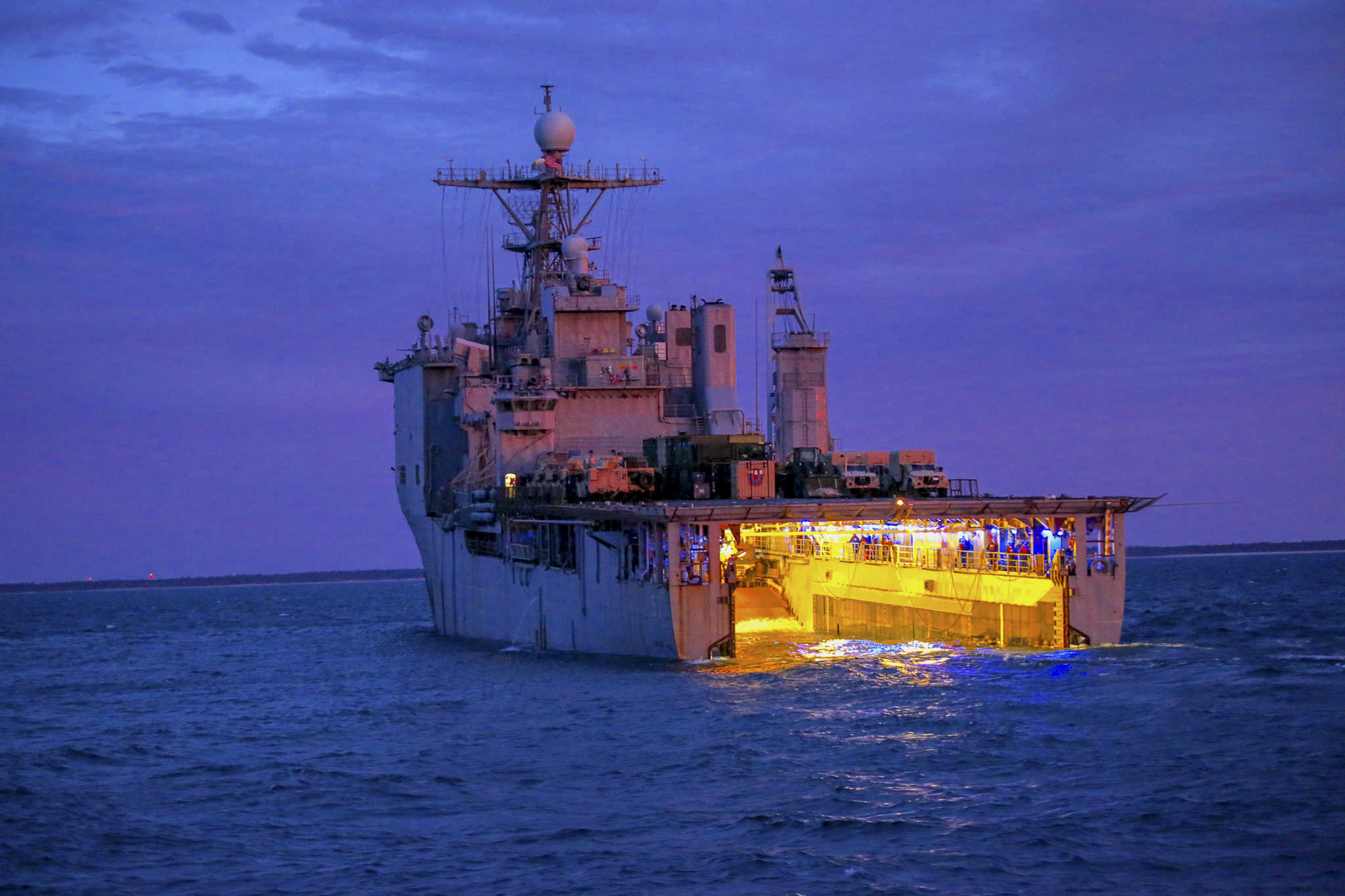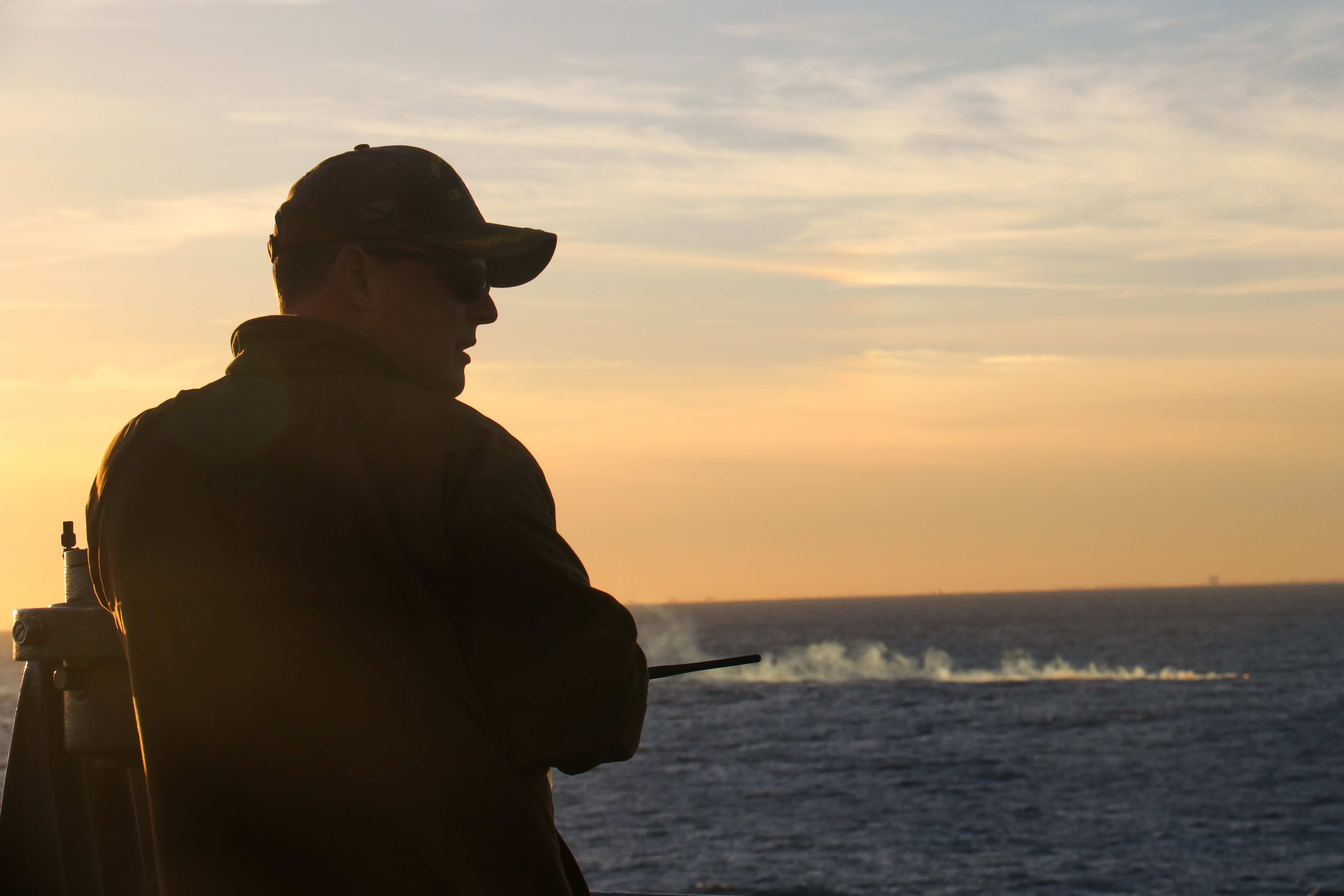Cmdr. Brad Fancher, commanding officer of the dock landing ship USS Carter Hall (LSD-50), observes the debris field of a high-altitude surveillance balloon on Feb. 4, 2023. US Navy Photo
A U.S. amphibious warship, explosive and ordnance divers and underwater robots are off the coast of South Carolina surveying about a square mile off the Atlantic Ocean for the remains of a high-altitude Chinese spy balloon a U.S. fighter shot down on Saturday, defense officials told reporters on Monday.
USS Carter Hall (LSD-50), Explosive Ordnance Disposal Group (EODGRU) 2, USNS Pathfinder (T-AGS-60) and an unidentified tug are off the coast of Myrtle Beach surveying the remains of the balloon and its surveillance payload, U.S. Northern Command commander Air Force Gen. Glen VanHerck told reporters on Monday.
On Saturday, an Air Force F-22 Raptor fighter fired an AIM-9X Sidewinder anti-air missile from 58,000 feet to hit the balloon, which was flying at about 62,000 feet above U.S. territorial waters, officials said on Saturday. The mission was in part crafted to minimize the risk to people on the ground and keep the debris in U.S. territorial waters. Additionally, guided-missile destroyer USS Oscar Austin (DDG-79) and guided-missile cruiser USS Philippine Sea (CG-58) were operating in the vicinity of the crash site. Both ships are equipped with the powerful AN/SPY-1 air search radar.
The ships have been on “station in the vicinity of the splashdown and they’ve been collecting debris [and] categorizing the debris since arrival,” VanHerck said.
“Pathfinder is a ship that conducts survey operations using sonar and other means to map out the debris field. It’s capable of conducting oceanographic, hydrographic, bathymetric surveys of the bottom of the ocean to do that and they’ll eventually produce us a map.”
Debris recovery efforts were curtailed on Sunday due to the high sea state, but by Monday EOD sailors on rigid hull inflatable boats (RHIBs) were underway to survey the remains. Underwater surveillance robots with side scan sonar were on station evaluating a 1,500-meter by 1,500-meter square debris field.

USS Carter Hall with the 24th Marine Expeditionary Unit (MEU) and Iwo Jima Amphibious Readiness Group (ARG) stages after offloading a Landing Craft Utility (LCU) in the early morning, beginning an amphibious assault during Composite Unit Training Exercise (COMPTUEX) at Camp Lejeune, N.C., on March 15, 2021. US Navy Photo
“The FBI is embedded with us on our salvage operations as we collect this [debris],” VanHerck said. “I don’t know where the debris is going to go for final analysis. But I will tell you that certainly, the intel community along with the law enforcement community that works under counterintelligence will take a good look at it.”
The Coast Guard has also dispatched cutters USCGC Venturous (WMEC-625), USCGC Richard Snyder (WPC-1127) and USCGC Nathan B. Bruckenthal (WPC-1128) to assist in the search and recovery.
The Navy is preparing an additional contracted, commercial offshore support vessel at Joint Expeditionary Base Little Creek-Fort Story, Va., and to assist in the recovery effort, USNI News has learned. The OSV HOS Rosebud was moored at the JEB Little Creek-Fort Story as of Monday morning, according to the automated identification system.
On Monday, VanHerck gave more specifics as to the size of the spy balloon. The balloon itself was 200 feet high. He estimated that the surveillance payload was about the size of a regional commercial aircraft and weighed about 2,000 pounds.
The size and weight of the aircraft fed into the decision to down the balloon over the water, he said.
“From a safety standpoint, picture yourself under large debris weighing hundreds if not thousands of pounds falling out of the sky,” he said.
“That would give you an idea of the perspective… and the decision-making process along the way.”
Additionally, there were damage risks from falling solar panels and batteries that were part of the surveillance payload. There was also a risk that explosives were onboard, VanHerck said.
The balloon and the payload crashed in relatively shallow water – about 50 feet deep – off the coast of South Carolina. The shallow depth will increase the speed of the survey and recovery, Sal Mercogliano, a maritime historian at Campbell University, told USNI News.
The emphasis will be on the underwater unmanned vehicles to survey and locate parts from the crash and to then bring them to the surface, he said.
The balloon entered the U.S. air defense identification zone Near Alaska on Jan. 28 and crossed into Canada on Jan. 30. On Jan. 31, the balloon crossed from Canada into Idaho. VanHerck said the balloon flew over sensitive military sites, but would not specify where. It was spotted flying over the intercontinental ballistic missile silos at Malmstrom Air Force Base in Montana.
The Chinese surveillance balloon is one of several to transit over U.S. airspace over the last few years, Pentagon officials said Sunday.
“PRC government surveillance balloons transited the continental United States briefly at least three times during the prior administration and once that we know of at the beginning of this administration, but never for this duration of time,” a U.S. defense official said Sunday.












No comments:
Post a Comment
How did you like the post, leave a comment. I would appreciate hearing from you all. Best wishes from JC's Naval, Maritime and Military News